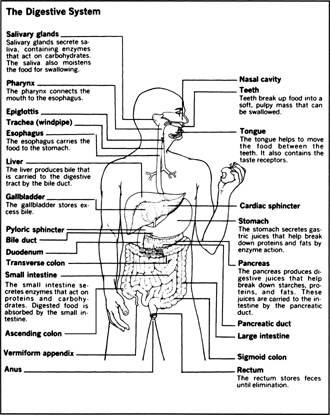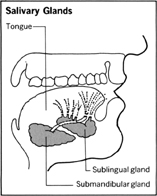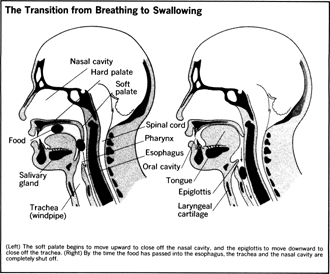The Digestive System and the Liver - The mouth: saliva, teeth, and tongue
By the time food leaves the mouth and is pushed down into the gullet (or esophagus), it has already received a sampling of all the kinds of punishment and prodding that will be provided by the 30-foot tube that lies ahead of it. The chances are slim that any piece of food will end that journey in the same condition it started, but if it did it would have traveled those 25-30 tortuous feet at the rate of something less than two feet per hour. Normally, the elapsed time is between 17 and 25 hours.
As in the rest of the digestive tract, the mouth puts both chemical and mechanical apparatus to work on a bite of food. Saliva supplies the chemical action. Teeth and tongue, backed up by powerful sets of muscles, are the mashers, crushers, and prodders.
Saliva
The mere presence of food in our mouth—or even the smell, memory, or anticipation of it—sends signals to our brain, and our brain in turn sends messages back to a system of six salivary glands: one pair, called the sub-lingual glands , located under the tongue toward the front of the mouth; another pair, the submaxillary (or submandibular ) glands, a bit behind and below them; and the largest, the parotid glands , tucked in the region where jaw meets neck behind the ear lobes.


Saliva is mainly composed of water, and water alone begins to soften up food so that it can pass more smoothly down the esophagus toward encounters with more powerful chemical agents.
There is also a very special substance in saliva, an enzyme called ptyalin , whose specific job is to begin the breakdown of one of the toughest kinds of food our digestive system has to handle—starches. Starch is a kind of carbohydrate, the group of foods from which we principally derive energy; but in order for the body to utilize carbohydrate, it must be broken down into simpler forms, which are called simple sugars. Ptyalin, then, begins the simplification of carbohydrate starch into carbohydrate sugar.
Saliva also does a favor or two for the dominating structures of the mouth—the tongue and teeth. Without its bathing action, the tongue's taste cells could not function up to par; and because it has a mild germicidal effect in addition to a simple rinsing action, saliva helps protect our mouth and teeth from bacterial infection.
Teeth
The role of the teeth in digestion can be summed up in one word: destruction. What the wrecker's ball is to a standing building, our teeth are to a lump of solid food. They do the first, dramatic demolishing, leaving smaller fragments to be dealt with and disposed of in other ways.
Starting from the center of the mouth, we have two incisors on either side, top and bottom, followed by a canine, a couple of premolars, and three molars, the most backward of which (it never appears in some people) is the curiously named “wisdom” tooth, so called because it commonly appears as physical maturity is reached, at about 20 years of age.
Our teeth equip us for destroying chunks of food by a gamut of mechanical actions ranging from gripping and puncturing to grinding and pulverizing. The teeth in front—canines and incisors—do most of the gripping, ripping, and tearing, while the premolars and molars at the back of the jaws do the grinding.
The Tongue
The surface of the tongue is not smooth, but has a finely corrugated look and feel. This slightly sandpapery surface results from the presence of thousands of tiny papillae, little pyramid-shaped bumps. When we are young, the walls of a single papilla may contain up to 300 taste cells, or buds. As we get older, the maximum number of taste buds per papilla may decline to under 100.
There are four kinds of taste cells, distinguished by the type of taste message each sends to the brain: salty, sweet, sour, and bitter. Each of the four types is a narrow specialist in one type of taste. However, simultaneous or successive stimulation of all four types (combined almost always with information picked up by our sense of smell) can produce a tremendous variety of recognizable tastes—although perhaps not so many as some gourmets or wine-tasters might have us believe.
All four types of taste buds—salty, sweet, sour, and bitter—are found associated with papillae in all areas on the surface of the tongue; but there tend to be denser populations of one or the other kinds of taste cells in certain places. For example, salty and sweet cells predominate at the tip of the tongue and about halfway back along its sides; sour cells are more numerous all the way back along the sides; bitter buds are densest at the back of the tongue.

In addition to its tasting abilities, the tongue is a very versatile, flexible, and admirably shaped bundle of muscle. Not only can it flick out to moisten dry lips and ferret out and dislodge food particles in the oral cavity, but it also performs the first mechanical step in the all-important act of swallowing.
Swallowing
Swallow. You'll find that you feel the top of your tongue pressing up against the roof of your mouth (hard palate). You may never have thought about it consciously, but the pressing of the tongue against the hard palate prevents food from slipping to the front of your mouth—and also gives the food a good shove up and to the back of your mouth. At this point, the soft palate (from which the teardrop-shaped piece of tissue called the uvula hangs down) slips up to cover the passageway between mouth (oral cavity) and nasal cavity, nicely preventing the food from being misdirected toward your nose.
Once past the soft palate, the food is in the pharynx , a kind of anatomical traffic circle with two roads entering at the top, those from the mouth and nasal cavity, and two roads leading away from the bottom, the trachea (windpipe) and the esophagus or food tube.
The Epiglottis
A wedge of cartilage called the epiglottis protrudes from the trachea side, the side toward the front of the neck. When we are breathing, the epiglottis is flattened up against the front wall of the pharynx, allowing free movement of air up and down the trachea. Simultaneously, the epiglottis helps to close off the entrance to the esophagus; a good part of the esophagus-closing work is done by a bundle of sinewy, elastic tissue we associate primarily with speech—the tissue of the vocal cords, otherwise known as the voice box or larynx . The laryngeal tissue is connected to the epiglottis above it, and supplies the epiglottis with most of its muscle for movement.
During the movement of a swallow, the larynx exerts an upward force against the epiglottis that serves to block off the trachea. At the same time, the larynx relaxes some of its pressure on the esophagus. Result: food enters the esophagus, where it is meant to go, and not the windpipe, which as we all know from having had something “go down the wrong way,” produces an immediate fit of coughing.
Once we have swallowed, we lose almost completely the conscious ability to control the passage of food along the intestinal tract. Only when wastes reach the point of elimination do we begin to reassert some conscious control.

Comment about this article, ask questions, or add new information about this topic: